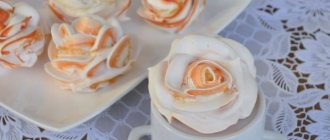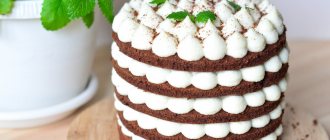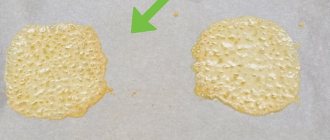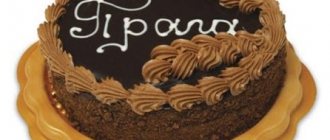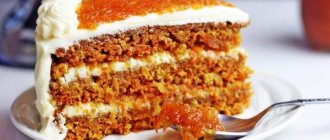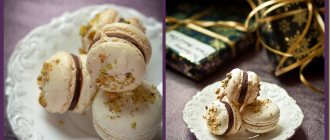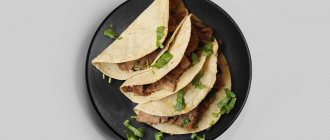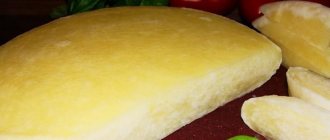What is mastic and how is it made?
Decorating a cake with fondant is becoming more and more popular every year. This fashion came to us from America several years ago. And now almost every confectionery shop decorates cakes with it and makes various decorations from it.
Mastic is an edible mass used to decorate confectionery products. Due to its high elasticity, it resembles plasticine, which makes it possible to produce a variety of decorative elements. Many confectioners completely cover the cake with it - this way you can give it any design using food baptists.
It is worth noting that jewelry made from this material is not only beautiful, but also edible. And all because mastic is prepared from natural foods and dyes. If you have prepared too much mass, then do not rush to throw away the part that you did not use. Just wrap it in cling film and put it in the freezer. In this state it can be stored for 3 months.
Mastic for cakes is prepared on the basis of powdered sugar. On a production scale, industrial mastic is used - it is ideal for the manufacture of decorative elements, including the smallest parts. Complex cooking technology does not allow it to be reproduced in everyday life.
Nowadays you can buy such dough in a store or make it yourself. Many housewives prefer to make it themselves, since in production during the preparation of mastic they add various other components, in addition to the main ones. Below are the types of mastic:
- Dairy;
- Honey;
- Gelatin;
- Marshmallow mastic;
They are not inferior to “professional” confectionery materials in appearance or taste, and preparation does not require special skill. It is important to remember that mastic does not tolerate moisture, so you should decorate with it a cake with dry cake layers (for example, a sponge cake) and soak it with butter cream.
Sugar mastic is the perfect way to decorate!
Sugar mastic began to be used quite a long time ago. It is not difficult to prepare, and mastic is used to decorate cakes, muffins and other confectionery products. It is used to make items for future use: flowers, figures, various decorative elements. This is a kind of confectionery plasticine. Specialized stores sell sugar mastic in finished form. But you can do it in your kitchen without any problems.
If you correctly follow the technology for preparing sugar mastic, you will come up with cake shapes of any complexity. It is necessary to prepare a mixture with the consistency of plasticine, which has flexibility, a uniform structure, and no lumps. Do not forget that the mass should not harden too quickly. All this is achieved using a certain composition based on powdered sugar. It turns out to be a kind of dough in which flour is replaced with sugar.
There is one more component that is often used. This is starch. It imparts plasticity, light structure, and has binding properties. The composition in different recipes can vary greatly: with gelatin or milk, with a more liquid or thick structure. But the taste, color and aroma are provided by special additives: juices, fruit syrups, food colorings.
Recipes for making mastic at home
For housewives who want to make their own sweet mass, rather than buying something ready-made in the store, we present the most popular recipes for making it at home. In addition to the required ingredients, you will need a rolling pin and board for rolling out the mixture, as well as plastic wrap to wrap the finished mixture before putting it in the refrigerator. If you want to give it color, use food coloring.
Honey mastic recipe
Previously, preference was given to making mastic from sugar, but now honey is most often used instead. It turns out to be much softer, and it is much easier to sculpt various figures from it, since it does not crumble or crumble.
In order to prepare honey mastic you will need:
- Powdered sugar – 900g;
- Honey – 175 g;
- Water – 40 ml;
- Gelatin – 15g.
Cooking method
- First of all, pour cold water over the gelatin and leave for 30 minutes.
- Sift the powdered sugar through a sieve.
- Take a bowl and combine ingredients such as honey and swollen gelatin.
- Place the bowl with the ingredients in a water bath.
- Heat the honey mass until the gelatin dissolves. Then strain carefully.
- 1 tbsp. Pour the powdered sugar into a bowl, combine the rest of the powdered sugar with the honey mass.
- Slowly start kneading the mixture.
- Gradually add the remaining powdered sugar. Continue kneading.
The mastic should be homogeneous, and when pressed, the depression retains its shape. Honey mastic is ready.
Gelatin mastic recipe for cake
This type of dough is best suited for making decorative elements - it is quite hard. You should work with it quickly, since gelatin tends to harden. The ingredients are very simple:
- Gelatin – half a teaspoon;
- powdered sugar – 100 grams;
- water – 2 teaspoons.
You can buy powdered sugar or make it at home by putting sugar in a coffee grinder.
Cooking method:
- Soak the gelatin in water and leave to swell for 30 minutes to an hour.
- After this time, place it in a water bath and stir regularly until all lumps dissolve. You cannot bring gelatin to a boil - it will be unsuitable for production.
- After obtaining a homogeneous mass, begin to gradually add powdered sugar.
Now you can start sculpting. If the mass has frozen, heat it in a water bath.
Marshmallow mastic recipe
Marshmallow is very popular in the West, while here it is not in great demand. Some compare it to marshmallows, but its taste is much lower. Despite this, marshmallow mastic turns out excellent.
You will need these ingredients:
- marshmallow - 200 grams;
- butter – 1 teaspoon;
- powdered sugar – 500 grams.
Instead of butter, you can use water or lemon juice.
Cooking method:
- Place the marshmallows in a microwave-safe bowl and add the butter. Set a timer for about 50 seconds - this is enough for it to melt.
- Once the marshmallows have melted, slowly add the powdered sugar, stirring gradually. The result should be a mass resembling plasticine. The main thing is not to overdo it with the powder, otherwise the mastic will harden and become very hard.
- When the mass reaches the desired consistency, wrap it in cling film and place it in the freezer for about 15 minutes. After this time, you can start working with it.
If you have made too much mastic, place the remainder in the freezer - it can be stored there for about 3 months.
Milk mastic at home
Mastic made from milk has the most pleasant taste among the various types of this confectionery material. There are several variations of the milk mastic recipe - elgreloo.com shares the most balanced of them.
Prepare the following ingredients:
- Powdered sugar – 160 grams
- Powdered milk – 150 grams
- condensed milk (uncooked) – 200 grams
- Lemon juice – 2 teaspoons
Instead of lemon juice, you can use water, but then the mass will be very cloying.
Cooking method
- Sift the mixed milk powder and powdered sugar through a sieve;
- Slowly add condensed milk into the sifted mixture, stirring constantly and add lemon juice.
- Having achieved the consistency of plasticine, wrap the mixture with cling film and place it in the freezer for 40 minutes.
From gelatin
This type of mastic is called pastillage: it is indispensable when you need to make durable parts to decorate a cake, for example, handles for a basket, but it is practically inedible because it is very hard. If pastillage is dried, it retains its shape very well, so it is sometimes used to make templates for sculpting figures with fine details.
Ingredients for cooking:
- powdered sugar – 240 g;
- starch – 120 g;
- gelatin – 1 tbsp. lie with a slide;
- cold water – 60 ml;
- citric acid – 1 tsp;
- honey, preferably artificial - 2 teaspoons.
Process:
- Pour gelatin with water for 30 minutes, then melt in a water bath, add citric acid and honey.
- Separately mix starch with powder and gradually add to the gelatin mixture until a homogeneous, smooth consistency is obtained.
- Line a bowl with cling film, pour the mastic into it, wrap it in film and refrigerate until the mass stops spreading.
- Before using the pastillage, you need to knead it well; if it is very cold and cannot be molded, you need to put it in the microwave for 5 seconds.
How to make mastic shiny or colored
You can add color to mastic in different ways. This can be done using dry food coloring, gel or natural. Dry dyes dissolve in a few drops of water, and then you need to drop a drop at a time on different parts of the dough, and then start kneading.
With gel dyes everything is much simpler. You only need to add 2-3 drops of the chosen color, and then mix the mastic thoroughly so that the dye is distributed evenly. Some housewives use natural dyes (vegetable and fruit). They do not give a rich color, but for decorating a homemade cake this is exactly what you need. In order to make the mastic shiny, you need 1 tbsp. vodka dissolve 1 tbsp honey. The resulting mixture is applied to the mastic with a brush after the cake is decorated with it. There will be no smell or taste of vodka - it will evaporate and only a glossy shine will remain.
Milk mastic
In order to prepare this type of mastic, you need to prepare the following products:
- powdered milk – 160 g.
- condensed milk – 160 g.
- lemon juice – 1 tsp.
- powdered sugar – 150 g.
Cooking:
- Mix all ingredients in a bowl and mix thoroughly until it reaches the consistency of plasticine. The mastic will turn beige.
- You can easily color it by adding a few drops of dye. This mixture is mainly used to cover the cake and sculpt small figures.
Best tips for making mastic at home
To ensure that your mastic succeeds the first time, we have prepared for you a list of tips that will help you with this.
- Be sure to sift the powdered sugar through a fine strainer. If this is not done, then there may be sugar in it, which will cause the dough to tear.
- After the mastic is ready, wrap it in cling film or a plastic bag and place it in the refrigerator for 30 minutes. During this time, it acquires plasticity.
- If you need to paint the mastic in different colors, then prepare the base, then divide it into different portions, add dyes and knead until a uniform color is obtained.
- To decorate a cake with fondant, you shouldn’t immediately run to the store and buy special devices for this. You can roll out the mastic with an ordinary rolling pin. After wrapping the cake, you can trim the edges using a pizza cutter. You can use cookie cutters for decoration.
As you can see, making your own mastic is quite simple. This article on Elgreloo.com collected the best recipes for making mastic at home. Now you can make it not only from sugar, but also from honey, milk powder, marshmallows or gelatin. You also learned how to paint it in different colors and add shine. Get creative, decorate cakes with different mastic figures and delight your loved ones with homemade delicious and beautiful cakes.
Video recipe for cake mastic
Let’s check the video again to see how to successfully whip up the base for the white homemade cake mastic described above.
That's almost all, I just wanted to add a couple more sentences. I don’t know about you, but I love preparing cakes according to individual recipes for the ingredients: first I choose the cake layers I like, then I look through the options for cream and glaze, and then I make homemade mastic. This approach gives a lot of room for experimentation and turns our kitchen routine into very varied and creative work. In addition, check out the delicious and beautiful chocolate cake frosting, famous for the fact that it does not crack after drying and does not slide off the product in waves; it is a pleasure to apply! In general, experiment and you will succeed! Thanks for your attention to the recipe! I would be very glad if you write me your feedback on preparing the mastic for the cake described above, and also share your own ideas on this matter. Happy creativity everyone!
Other cake recipes
Chocolate icing Chocolate cake with cherries Chocolate cake Kefir cake Chocolate cake Happy reading!
Reader reviews
Nobody has written anything yet. Be the first!
Honey mastic
The name suggests that this species is prepared from honey. The structure of honey mastic is soft, making it quite comfortable to create various figures and decorations. Honey mastic is also used for covering cakes. This mastic has the advantage that it does not crumble when applied and does not crumble.
Products for honey mastic:
- honey – 170 g.
- gelatin – 15.
- water – 50 ml.
- powdered sugar – 900 g.
Recipe:
- Soak the gelatin in water for 30 minutes.
- Melt it using a water bath, then pour in honey.
- Powdered sugar must be divided into two disproportionate parts. Place one part of the powder aside, and pour the other part into gelatin mixed with honey.
- Mix all the ingredients and knead the dough, gradually adding the rest of the powder.
- Honey mastic is ready when marks and indentations remain on it when pressed.
What utensils will you need?
To make cake mastic with your own hands at home, you need to prepare the dishes. To do this, you will need a container for mixing the components, which can be enameled, plastic, ceramic, or glass. To heat the mass in a microwave or oven, you should prepare a form made of porcelain or glass that is temperature-resistant. In addition, you will need a rolling pin, microwave, mixer, and a clean work surface.
Step-by-step recipes for making homemade mastic for decorating a cake
How to make mastic at home? The composition can be very different, but powdered sugar remains unchanged and the main component. There are many methods for preparing this material for a cake with your own hands at home, but the simplest is marshmallow paste. The finished mass is stored in the refrigerator, tightly wrapped in cling film. Before sculpting, it is slightly heated in the microwave or oven. The finished figures must be given time to dry.
- What to do in case of sudden pressure surges
- What are the benefits of lentils?
- Azopyram test
Milk mastic
Milk mastic for cake is one of the most famous and popular types. Its color turns out to be a little yellowish. Milk mass at home is easy to make and convenient to use. Suitable for cake bases, creating small flowers and other figures. Required components:
- 350 g baby formula;
- 1 can of condensed milk;
- 350 g powdered sugar.
Step-by-step making of milk mastic for a cake with your own hands at home:
- Add all ingredients to the pan and mix.
- Knead until smooth and elastic.
- Form a ball and sprinkle with powder.
- Wrap the mastic in plastic wrap and leave for 30 minutes.
Marshmallow based mastic
How to make mastic from marshmallows? Preparing this type of plastic mass is not difficult. The number of components given in the recipe is enough to completely cover the product and sculpt several figures. It is better to choose plain marshmallows. Required ingredients:
- marshmallows – 200 g;
- powdered sugar – 500 g.
Step-by-step master class of marshmallow-based cake mixture with your own hands at home:
- Place the marshmallows inside a container to heat in the microwave. If you don’t have such a device, heat it in a water bath. Add a piece of butter. Set for 40 seconds or more until the volume of the base doubles.
- Sift the powdered sugar in portions and mix the mastic with a spoon. If you want to make it colored, add dye right away.
- When mixing with a spoon becomes difficult, sprinkle the table with powder and knead with your hands. This process takes a long time, since there should be no air bubbles in the mass.
- When the mastic stops sticking, wrap it in cling film and leave for half an hour. After this, you need to knead it, rolling it out with a rolling pin.
- You can store the mixture in the refrigerator for up to three months. Before use, it must be heated in the microwave, kneaded with the addition of powdered sugar.
Chocolate mastic recipe
The consistency of chocolate mastic resembles plasticine. It allows you to make different figures that will have a pleasant brown color and taste. Chocolate for mastic must be chosen milk, white, bitter, depending on the result you want to get. Required ingredients:
- water – 3 tsp;
- powdered sugar – 200 g;
- chocolate – 100 g;
- marshmallow – 150 g;
- butter;
- potato starch.
Step-by-step recipe for DIY chocolate cake mixture at home:
- Place the marshmallows inside the container and add two teaspoons of water. Mix chocolate with a teaspoon of butter and tsp. water.
- Heat the marshmallows in the microwave until they expand. Melt the chocolate there and grind it so that there are no pieces.
- Mix marshmallows with sifted powdered sugar and add chocolate. Mix the mixture until smooth. Beat with a mixer fitted with spiral attachments.
- Sprinkle with starch and knead until soft and elastic.
- Wrap the mastic in film and let it sit for half an hour.
Recipe for mastic made from powdered sugar and gelatin
This recipe is considered one of the most successful ways to make mastic for a cake with your own hands at home. The mass turns out to be white, soft, easy to roll out in a thin layer, universal (suitable for sculpting flowers, figures, covering). You can store the mastic at room temperature, but before use it must be heated in the microwave. Required components:
- gelatin – 25 g;
- cold water – 1 glass;
- sugar – 2 cups;
- invert syrup – 170 ml;
- powdered sugar – 1.2 kg;
- starch – 300 g;
- salt – 0.25 tsp.
Step-by-step recipe for making cake mastic with your own hands at home:
- First we will deal with invert syrup. It replaces molasses, maple syrup, liquid honey, and confectionery glucose. To prepare it, put a saucepan with 700 g of sugar and 300 ml of hot water on low heat. Bring to a boil with constant stirring. Add 4 g of citric acid, stir, cover with a lid, and cook for 30 minutes over low heat. Remove the lid and let the syrup cool for 15 minutes. Add 3 g of soda, after which abundant foaming should begin. Stir the syrup with a spoon several times at intervals of 10-15 minutes to remove the foam. Set aside 170 ml of syrup for the mastic, store the rest in the refrigerator.
- For mastic, pour gelatin with half a glass of water. We prepare it as indicated on the package. Once ready, strain so that there are no grains.
- Mix the remaining water, salt, sugar, invert syrup. Place on low heat and bring to a boil while stirring constantly.
- When the mixture boils, reduce the heat and simmer for 8 minutes, but there is no need to stir.
- Turn on the mixer and pour the boiling mixture into the gelatin. Beat at maximum speed.
- It is necessary to beat for a long time so that the mass increases three times. It should become uniform, fluffy, white, shiny and curl into the corollas.
- Then we change the nozzles to spiral ones. Sift through the powder and add in several additions. We continue to beat.
- When the snow-white dense mass is ready. Cover the container with mastic with cling film and leave for a day at room temperature. Then knead on a table sprinkled with starch.
Marzipan mastic
Marzipan mastic comes out smooth and elastic. It is used to completely cover the surface of pies and cakes. Less commonly used for sculpting flowers, fruits, and other figures. Required ingredients:
- sugar – 1 glass;
- almonds – 1 cup;
- powdered sugar;
- cocoa powder – 1 tbsp. l.;
- almond essence – 3 drops;
- water – 0.25 cups.
Step-by-step recipe for do-it-yourself marzipan cake mixture at home:
- Without peeling, place the almonds in boiling water, boil for a couple of minutes, and transfer to a colander. When all the water has drained, pour the almonds onto the board. Remove the shell, wash the kernels, fry in a dry frying pan for 15 minutes with constant stirring. Grind the nuts in a blender until pureed.
- Mix sugar with water, heat until the syrup dissolves and thickens so that it rolls into a flexible, hard ball.
- Mix syrup with almonds. Warm up for 4 minutes. Pour in the essence.
- Sprinkle the board with powder, spread the mastic and knead.
- Mascarpone cream
- How to detect the first symptoms of cancer
- How to receive a pension for an incapacitated pensioner to a trusted person
Protein-rice mass
This type of mastic is considered very common. Judging by the reviews, it is used to form small patterns, use for cornets or the smallest nozzle. What is the protein-rice mixture made from? Its peculiarity is the addition of protein and lemon juice. Required components:
- powdered sugar – 200-220 g;
- lemon juice – 1 tsp;
- protein – 1 pc.
Step-by-step production of protein mixture for a cake with your own hands at home:
- Transfer the whites into a container. Beat it a little with lemon juice.
- Gradually stir in the sifted powder in batches.
- The mass should flow slightly from the spatula, but not be liquid.
Floral
Do-it-yourself floral mastic for a cake at home is a unique type of mass that perfectly retains its given shape, hardens in a short period of time, and is easy to mold. Required components:
- cold water – 30 ml;
- powdered sugar – 250 g;
- liquid glucose – 1 tsp;
- gelatin – 2 tsp.
Step-by-step preparation of flower mass with your own hands at home:
- Pour water into a small bowl, add gelatin, leave for 10 minutes. Then heat until dissolved in a water bath.
- Mix glucose into gelatin and mix.
- Gradually add sifted powdered sugar in portions.
- Place the thick mastic on a surface sprinkled with powder and knead until the stickiness disappears. Wrap it in film and let it sit for half an hour.
